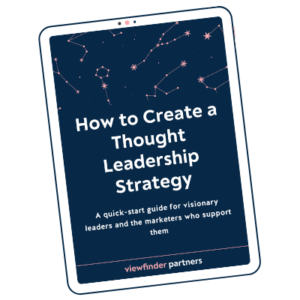In my work with thought leaders, I’ve learned a lot about what makes great thought leadership sing. But you know what’s even more helpful? Learning what makes thought leadership get stalled and stuck.
Why do smart people with the best intentions (and razor-sharp marketing teams) sometimes get mired in their own ideas?
Three reasons: they don’t have a clear voice, they have too many ideas, or they’re not thinking big enough.
Here’s what I’ve learned about the most common thought leadership problems—and how to solve them.
Thought leadership problems and solutions
No clear voice
 I call this the “Says who?” problem. People (not companies) are thought leaders. People have individual voices, experiences, and perspectives. But sometimes, a group of people at a company want to put out a piece of thought leadership together. Writing as a group isn’t a problem, and I work with many author teams to write articles.
I call this the “Says who?” problem. People (not companies) are thought leaders. People have individual voices, experiences, and perspectives. But sometimes, a group of people at a company want to put out a piece of thought leadership together. Writing as a group isn’t a problem, and I work with many author teams to write articles.
The problem comes when the human voices of the group get lost, and a royal “We” takes over.
The piece starts to feel like anyone could have written it (insert CMO here).
Or it feels like no one wrote it (ChatGPT and your friends, I’m looking at you).
Instead of using first-person language (“Our team saw X happening so we did Y”), passive voice takes over (“One might consider…”).
It stops feeling like thought leadership (reflections on someone’s work) and starts feeling like branded copy.
If you find yourself asking, “Says who?” it’s time to realign the piece with the people behind it.
Too many ideas
 “Too many ideas” is the primary reason I see thought leadership projects get stuck. You have too many ideas and haven’t landed on which one is THE idea, so you try to squeeze them all in.
“Too many ideas” is the primary reason I see thought leadership projects get stuck. You have too many ideas and haven’t landed on which one is THE idea, so you try to squeeze them all in.
Maybe you don’t especially love any of the ideas, but stacking a bunch of half-hearted ideas on top of each other seems like the path to something bigger and better. (Spoiler alert: That never works.)
Here’s what I’ve learned: Think like an editor. When I help clients pitch their ideas to magazine editors, I’ve learned to be incredibly ruthless about whittling down to ONE IDEA. (You only get one!)
If I send an editor a convoluted pitch that ties together too many different themes and asides—if I’m trying to boil the ocean instead of going deep on one angle—they will send it right back to me.
When you think like an editor, you really start thinking like your reader. You kill your darlings. You ask questions like, “Wait a minute. How does that fit in here?” You simplify. You tell a clearer story. You eliminate all the excess to focus on one big idea and explain that one idea more clearly.
If you’re feeling stuck, start simplifying. Remember: You only get one idea at a time.
No room to grow
 We’re currently in back-to-school season, and when I’m shopping for new shoes and clothes for my elementary schoolers, I want them to have room to grow. I don’t want to be buying new shoes next month.
We’re currently in back-to-school season, and when I’m shopping for new shoes and clothes for my elementary schoolers, I want them to have room to grow. I don’t want to be buying new shoes next month.
I think about thought leaders’ big ideas in the same way. When I work with someone to develop a big, long-term thought leadership platform, I’m hunting for an idea that’s big and inclusive enough that we can build on it over time.
The idea has to be expansive enough to allow for inevitable change—change in the world and change in the thought leader’s perspective over time.
I worked with a CEO and his team to build a platform based on one word. Many years later, it’s still growing and evolving, spawning a book, a podcast series, countless articles, and more. It worked because the word (“joy”) was big enough to build on over time.
The lesson here: Don’t be too prescriptive or rigid when you’re developing thought leadership. Inject your idea with a heavy dose of humility and room to grow. Your context, opinions, and audience will change between now and when someone comes across your idea for the first time years from now.
If you’re building for the long haul, be clear about what you want to be known for, but make sure the topic is big enough to relate to current You and all the future Yous that are coming. I’ve explained this before as being willing to let your idea “grow deep roots and wide shoots.” Be curious about where your idea could land next.
To develop thought leadership that builds momentum, brings people along, and moves your business forward, remember: Establish your voice, simplify your ideas, and give yourself room to grow.
Do you need help getting your thought leadership on track? I help leaders talk about their work. Learn more about thought leadership strategy and ghostwriting services.






